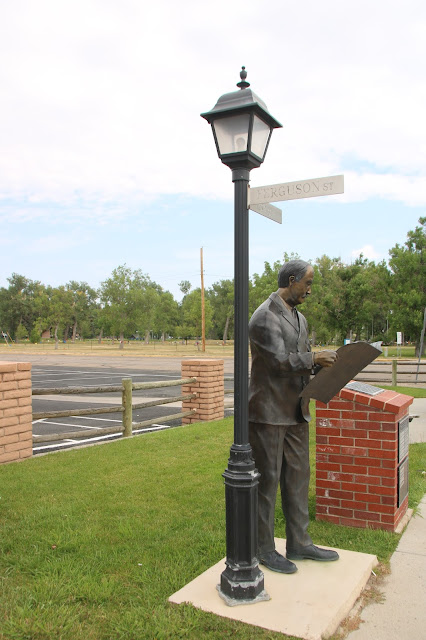September 2017 - Cheyenne Wyoming
This was an impulse visit as the museum we planning on visiting didn't open on weekends and I think this was the better choice.
The Frontier Days Old West Museum was founded in 1978. It is dedicated to interpreting, conserving and exhibiting the history and material culture of Cheyenne, Cheyenne Frontier Days, the State of Wyoming and the American West. The museum features the Cheyenne Frontier Days Hall of Fame. Permanent exhibits include Western horse-drawn carriages and wagons, the history and memorabilia of Cheyenne Frontier Days rodeo celebration, local history of Cheyenne, pioneer artifacts and clothing, and Western and folk art.
This will be part one of the museum, starting with the outside exhibits.
Cheyenne supports its volunteers in a big way and have annual awards presented.
The award draws its inspiration from Col. E.A. Slack, owner, publisher and editor of the Cheyenne Daily Sun-Leader, an early predecessor of the Wyoming Tribune Eagle. After a traveling railroad agent suggested the creation of a local festival to help drive passenger traffic, Slack used his influence to build support for such an event and even suggested the name Frontier Days in one of his editorials. Following news stories and editorials in Slack’s newspaper, other community leaders jumped on the bandwagon and produced the first Frontier Day on September 23, 1897. What is now the world’s largest outdoor rodeo and Western celebration is made possible only by the work of more than 2,000 volunteers.
A life-size bronze statue of Slack — appropriately, reading a newspaper — stands at the entrance to the Frontier Days headquarters to honor that volunteer spirit. The statue, created by Cheyenne artist Rich Haines, was commissioned by the Wyoming Tribune Eagle in 1997, the 100th anniversary of the first Frontier Day rodeo.
The lamppost represents community spirit shining down on Col. Slack and people like the award recipients who play an active role in our community. The street signs of Ferguson and 16th mark the site of the Tivoli Building where the Frontier Day planning committee originally met. Winners of the Community Spirit Award receive a miniature of the statue.
On the front cover of the newspaper is a representation of the first Frontier Day edition of the Sun-Leader in 1897; on the inside cover is a depiction of the Tribune Eagle and the presentation of the first Community Spirit Award in 1998.
Champion Lane Frost Memorial sculpture to the world champion Bull Rider Lane Frost who lost his life competing in the bull riding at Cheyenne Frontier Days 1989 sculpted by Chris Navarro.
This cowboy is riding a horse.
Cowgirls have been an important part of Cheyenne Frontier Days ever since 1904, when Bertha Kaepernick wowed audiences in a bronc riding exhibition.
One of the most famous cowgirls to ever compete at CFD is Eloise “Fox” Hastings. At 16, Hastings ran away from home and joined the Irwin Brother’s travelling Wild West Show. In addition to bronc riding, she was also a trick rider and the first woman to ever compete the in “bulldogging” steer wrestling competition.
Hastings was married to another CFD legend, Mike Hastings. Although he had won the 1931 steer wrestling contest, his better half was far more famous than her husband.
Another legendary cowgirl was Marie Fitzer Danks. Like Fox Hastings, she too was married to a rodeo star. Clayton Danks was a CFD saddle bronc and steer roping champion and is believed to be the cowboy depicted on Wyoming’s inconic Bucking Horse and Rider logo.
In 1908, Mrs. Danks won the Denver Post Ladies Relay at Frontier Days, claiming a larger prize than her husband had won for both of his previous victories.
In those days, husband and wife teams were common on the rodeo circuit. Many of them were well known performers at CFD, including world champion bulldogger Dell Blancett and his wife Bertha, famed trick rider Prairie Rose Henderson and her husband Charles Coleman, Barnie and Goldie St. Claire, Brian and Ruth Roach, Dick Shelton and Reine Hafley, Curly Roberts and Rose Smith, Hugh and Mabel Strickland and “Skeeter Bill” Robbins who was married to 1914 Ladies Relay winner Dorothy Merrell.
























...the story of the 'Wild West' has always been alluring. It's nice to see history kept alive. Thanks Jackie for sharing, please stop back again.
ReplyDeleteWhat wonderful Western history! A great place to visit and learn. LOVE the bronze sculptures. And I loved reading about those sassy cowgirls!
ReplyDeleteThose bull riders are in a league of their own! The statues are fantastic & I loved your shot looking over his arm to read the paper!
ReplyDeleteA great museum!
A classically western town!
ReplyDelete